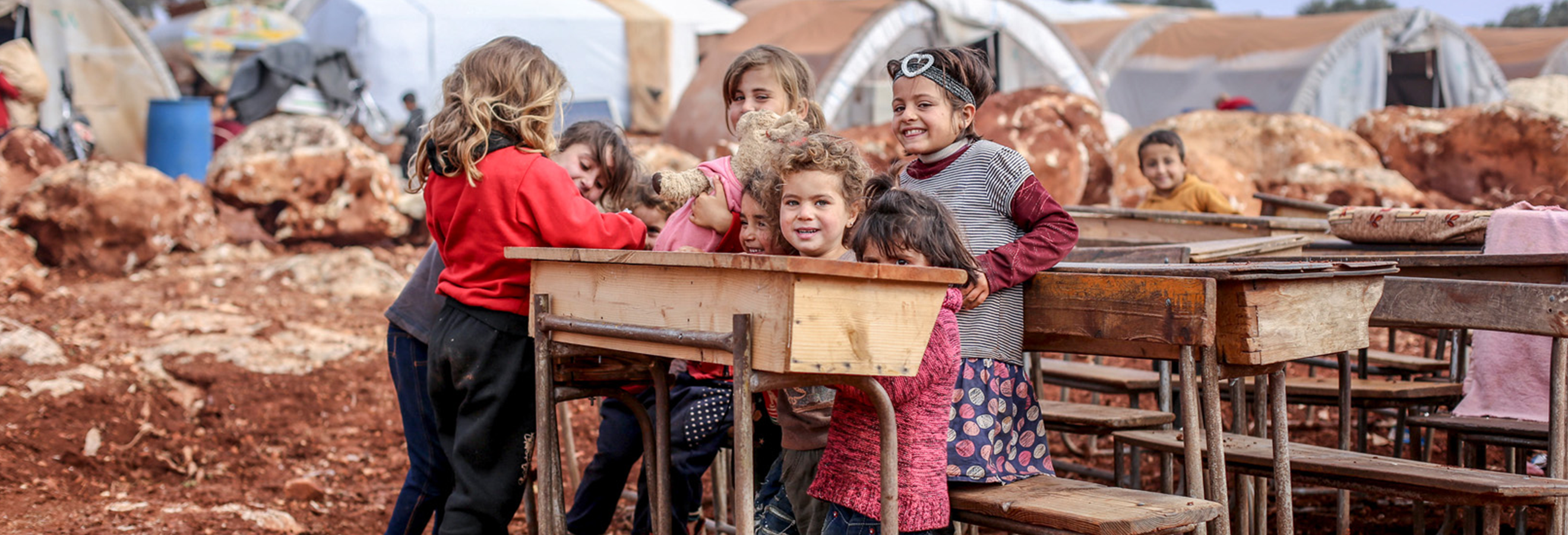
Education in crisis situations: A commitment to action
Education is under threat
The world is witnessing an alarming increase in the number of people affected by armed conflict, forced displacement, including large-scale refugee displacement, health and climate-induced disasters, and other crises. This means disrupted education for 222 million school-aged children and youth and education systems pushed to the brink of their capacities to deliver. Girls and children with disabilities, together with many other minority groups including but not limited to indigenous communities, ethnic and religious minorities and LGBTQI individuals are disproportionately affected in many crisis contexts. In 2022 alone, forced displacement reached a record high of 100 million people, over half of whom are children and youth in need of access to relevant quality education. In addition, between January 2020 and December 2021 there were 5,000 incidents of attacks on education and cases of military use of schools, with 9,000 students and educators abducted, arrested, injured, or killed across 85 countries. This is in addition to the schools closed due to armed conflict and political instability, where the education of future generations of girls, refugees and other population groups is at risk.
Education is underfunded
Humanitarian appeals for the education sector received only 22% of the funds requested in 2021, far less than other sectors. In 2021, only 2.9% of global humanitarian financing was allocated to education, considerably below the UN target of 4%. Following the outbreak of COVID-19, education only received 3% of total stimulus packages in response to the health crisis and only 0.7% of funds requested under the COVID-19 Global Humanitarian Response Plan.
Crises dramatically impact the longer-term investment required to transform education systems and ensure their resilience to future disruption. Overseas Development Assistance (ODA) to education was stagnant in 2020 and fell by US$359 million in the case of bilateral donors. This decline has since been followed by significant cuts to ODA by major donors. Governments in many countries have also been affected by slow economic recovery, rising debt costs and domestic reprioritization during and following COVID-19. Systemic issues in education funding nationally and globally mean that groups of children and youth, including but not limited to refugees and internally displaced persons, are missing out on both national and international support and are falling further behind.
Partnership for Transformation: A Commitment to Action
Building on promising practices, we, the Member States and partners seize the opportunity of the UN Secretary-General’s Transforming Education Summit to launch 'Education in Crisis Situations: A Commitment to Action.'
We commit to working together to transform education systems, so they are able to prevent, prepare for, respond to and recover from crises. In order to enable all crisis-affected children and youth, including refugees and stateless populations, to continuously, equitably and safely access inclusive, quality, safe learning opportunities.
In particular, we commit to improving access, quality, equity and inclusion for the 222 million children and youth whose educations have been interrupted or who are not learning due to armed conflict, displacement internally and across borders, and health or climate-induced disasters. In order to realize this commitment, we call on Member States, multilateral organizations, donors and education partners to work towards this commitment with a first reporting in 2025 before the 2030 target, and to hold each other accountable for the following actions:

Education access and learning outcomes
Improve equitable inclusive education access and learning outcomes for children and youth affected by crises, including by:
- a. Establishing a global system to track the number of crises affected children and youth, disaggregated by gender, disability, legal status and other relevant fields) reached by education on annual basis.
- b. Halving the number of out-of-school children and youth in countries affected by emergencies and protracted crises.
- c. Improving foundational learning outcomes so that double the current number of children and youth in emergency and post-crisis contexts are reaching minimum literacy, numeracy and socio-emotional proficiency.
- d. Improving the recruitment, retention and continuous professional development of qualified female and male teachers and facilitators to ensure continuity of learning for crisis affected children and youth in safe spaces and teaching is gender-transformative and inclusive.
- a. Committing to better financing including improved tracking of financial flows to education in emergencies across both humanitarian and Development funding.
- b. Committing to supporting education in the immediate aftermath of a crisis and also in the longer term through sustainable, multi-year Official Development Assistance (ODA) to education, including by funding Global Partnership for Education and Education Cannot Wait funding and partnership platforms.
- c. Committing to adapting existing mechanism and developing and resourcing additional multi-year financing mechanism for LMICS to support them to eliminate barriers to national education systems for those outside the reach of current domestic and international financing, such as refugees and stateless populations – in line with the policies of hosting governments.
- d. Improving the efficiency of education spending and targeting resources towards the most marginalized; especially girls, persons with disability, refugees and other forcibly displaced learners.

Work together in the spirit of international cooperation
Build crisis-resilient education systems that ensure the protection of children and youth rights, and address learner needs in a holistic way, including health, wellbeing, nutrition, water, sanitation and protection from violence, sexual exploitation, and abuse.
- a. Aligning national priorities and international commitments to transforma the resilience of education systems to crises, including those set out in the Incheon Declaration, the Busan Partnership for Effective Development Cooperation, the Global Compact on Refugees, the Global Compact on Safe, Orderly and Regular Migration, the Global Partnership to End Violence Against children, and the Safe Schools Declaration and the Comprehensive School Safety Framework as well as other obligations under international law.
- b. Committing to cooperation across governments, humanitarian and development actors, working together in a coordinated way and via established coordination mechanisms to transform education systems.
- c. Committing to inter-ministerial and inter-agency collaboration across education, health, water, sanitation, and social protection sectors in education and humanitarian response planning.
- d. Hardwiring inclusivity and gender equality in our policies on education in emergencies and protracted crises, as well as planning and implementation priorities.

Take into account diverse crisis-affected contexts
Scale and mainstream high-impact and evidence-based interventions into policy and programming efforts, with a focus on eight inter-linked priorities:
- (i) teachers;
- (ii) community participation;
- (iii) gender equality and inclusion;
- (iv) early childhood education;
- (v) mental health and psychosocial support;
- (vi) protection from violence;
- (vii) equitable delivery of education technology and innovation, especially for the most marginalized children;
- (viii) meaningful child and youth engagement.

